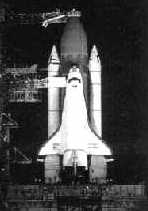Discovery returns
 the us space shuttle Discovery returned to Earth on August 20 with a satellite that has gathered data about ozone depletion in the Earth's atmosphere. The spacecraft had been launched successfully on August 8 after overcoming a communications glitch. It carried a sophisticated, reusable German science satellite crista-spas that studied the subtle chemistry of ozone depletion for nine days, before it was retrieved.
the us space shuttle Discovery returned to Earth on August 20 with a satellite that has gathered data about ozone depletion in the Earth's atmosphere. The spacecraft had been launched successfully on August 8 after overcoming a communications glitch. It carried a sophisticated, reusable German science satellite crista-spas that studied the subtle chemistry of ozone depletion for nine days, before it was retrieved.
Data from the satellite would help researchers fine tune computer models used to predict the impact of human activity on Earth's protective ozone layer. It's equipped with two major instrument packages to precisely chart the atmosphere's temperature and to measure ultraviolet radiation emitted or reflected from the atmosphere. A range of state-of-the-art equipment was used to gather data of the chemistry of ozone depletion and the global transport of gases affecting its destruction.
The astronauts also conducted a battery of projects, ranging from ultraviolet observations of comet Hale-Bopp, to testing of a sophisticated Japanese robot arm designed for use aboard the international space station.
The ozone layer shields Earth's surface from ultraviolet radiation from the sun that can cause cancer. Industrial pollutants are known to destroy ozone but it is not yet clear how the chemistry of that destruction works on a global scale. Mission scientist Jack Kaye said computer models about ozone depletion tend to under-predict the actual loss. Data from the crista-spas satellite, along with the results of balloon and rocket flights targeting the same regions of the atmosphere, should help clarify how trace gases that affect ozone levels are transported from one region to another.
